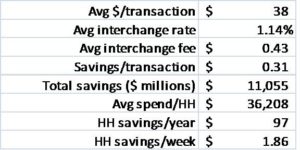The Fed released its proposal for debit card interchange rate changes, and proposed a flat 12 cents per transaction rate. The US Public Interest Research Group (USPIRG) issued a press release claiming that:
“The proposed regulations will benefit consumers by lowering the billions of dollars annually in non-negotiable swipe fees paid by merchants to large banks and the dominant credit card networks. These changes will lower the prices of everyday goods for all consumers including cash customers.”
My take: The impact on the average U.S. household — if any — will be negligible.
I’d love to see how USPIRG (and other consumer advocates who supported this regulatory change in the name of consumers) calculated their estimate of “lower prices of everyday goods.”
According to my calculations, if the interchange rate change was completely passed on by merchants and retailers to consumers, the average U.S. household would save $1.86 per week. You won’t be able to buy a single copy of the New York Times with that (not that you’d want to).
My calculations draw upon the Federal Reserve’s 2010 Payments Study showing the number of debit and credit card transactions and dollar volume and the National Retail Federation’s estimate of overall retail spending.
According to the Fed’s 2010 Payments study, the dollar value of the average debit card transaction is $38. At an average interchange rate of 1.14%, the average interchange fee per transaction was $0.43. With the proposed changes, that means retailers and merchants would save $0.31 per transaction.
Multiplying the total number of retail debit card transactions (per the Fed) by $0.31 yields $11.055 billion in savings to retailer and merchants. That’s 0.3% of the dollar value of all retail transactions. In other words, the total savings to merchants and retailers amounts to 0.3% of the total retail pie.
Based on the NRF’s estimate of total retail sales, the average US household spends $36.2k per year. If the percentage savings gets completely passed on to consumers, the average household will be able to reduce their spending by 0.3%, which comes to $97 year, or $1.86 per week.
This analysis, of course, is theoretical, and based on the “average” household which, many will argue, doesn’t exist. But the more important question to ask is: Why would merchants and retailers pass these savings on, rather than add to their bottom lines?
The answer is: If a decrease in prices results in a more-than-proportional increase in sales. And that’s where the projections and forecasts get murky.
If the cost of a six-pack of beer declined by 0.3%, from $6 a six-pack to $5.98, do you really think sales of beer would increase appreciably? (If you said “yes”, I’d say “REALLY?”).
Two cents to the consumer isn’t going to make a big difference. Two cents per six pack, over billions of six packs, adds up to Anheuser Busch.
Sorry, folks, but the proposed interchange rates are not going to see their way into consumers’ pocketbooks.








